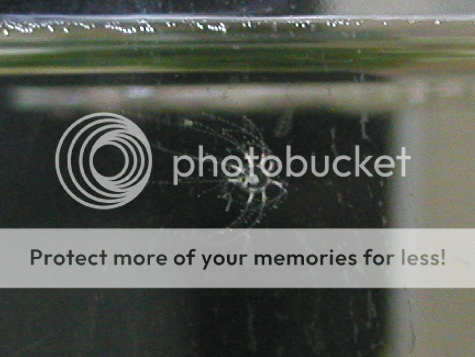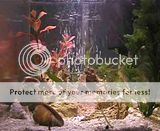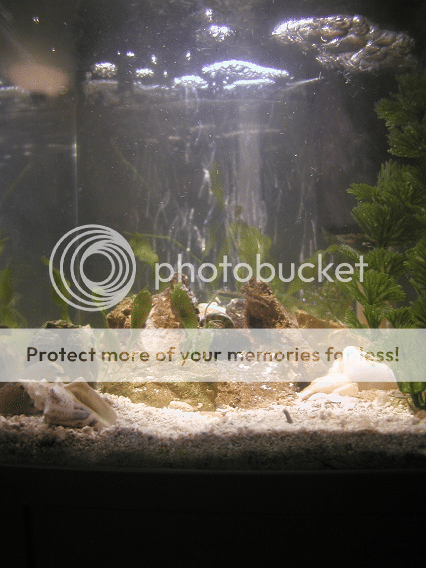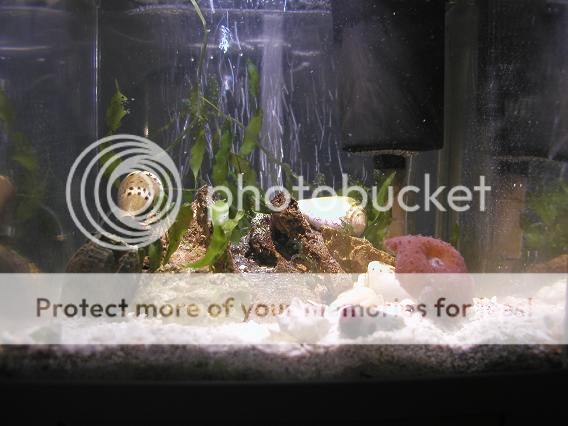Recently put in a new, much smaller C. strigatus. Following the removal of the other one that ultimately died, I noticed that the female started sitting around like a lump and not doing much. Water checked out and the behavior continued after a couple WCs, so not a pollution issue. I saw some similar behavior from a female small Clibanarius that lost a mate and even stopped eating for quite a long time until I put another "buddy" in. I don't usually subscribe to the idea of most hermits needing "buddies" all the time (since it certainly doesn't work out for all species), but it seems like sudden dissappearance of one memeber of a content pair or small-ish group causes a fair amount of distress in the remaining individual(s). With the new Ciliopagurus strigatus in, the original female is right back to normal activity.
Another tank mod: replaced the home-made filter cover with the bottom portion of a Fluval Edge prefilter (one of these dealies: http /www.petco.com/product/111694/Hagen-Fluval-Edge-Aquarium-Pre-Filter-Sponge.aspx ). It has a conveniently snug fit even though it's not even from the same brand. The female hermit was starting to rip apart the hot glue I'd used to hold the older foam slabs together, so a continuous piece of foam should hold up better.
/www.petco.com/product/111694/Hagen-Fluval-Edge-Aquarium-Pre-Filter-Sponge.aspx ). It has a conveniently snug fit even though it's not even from the same brand. The female hermit was starting to rip apart the hot glue I'd used to hold the older foam slabs together, so a continuous piece of foam should hold up better.
Also, the broad-leaf Caulerpa seems to be out-doing the grape Caulerpa. It's still having a bit of a stuggle getting established with the periodic beatings and stompings that the hermits inflict on it, but it's making progress slowly. The female hermit keeps snipping all of the balls off of the grape Caulerpa every time she gets a hold of it so that species is probably doomed in the long run since I can't keep propping it up. I'll try to get picks of how the other species is establishing as soon as my camera stops telling me the card isn't formatted.
Another tank mod: replaced the home-made filter cover with the bottom portion of a Fluval Edge prefilter (one of these dealies: http
 /www.petco.com/product/111694/Hagen-Fluval-Edge-Aquarium-Pre-Filter-Sponge.aspx ). It has a conveniently snug fit even though it's not even from the same brand. The female hermit was starting to rip apart the hot glue I'd used to hold the older foam slabs together, so a continuous piece of foam should hold up better.
/www.petco.com/product/111694/Hagen-Fluval-Edge-Aquarium-Pre-Filter-Sponge.aspx ). It has a conveniently snug fit even though it's not even from the same brand. The female hermit was starting to rip apart the hot glue I'd used to hold the older foam slabs together, so a continuous piece of foam should hold up better.Also, the broad-leaf Caulerpa seems to be out-doing the grape Caulerpa. It's still having a bit of a stuggle getting established with the periodic beatings and stompings that the hermits inflict on it, but it's making progress slowly. The female hermit keeps snipping all of the balls off of the grape Caulerpa every time she gets a hold of it so that species is probably doomed in the long run since I can't keep propping it up. I'll try to get picks of how the other species is establishing as soon as my camera stops telling me the card isn't formatted.





 ), and the the Nassariids in the tank were very, very unhappy as a result. Changes as a result:
), and the the Nassariids in the tank were very, very unhappy as a result. Changes as a result:


 It has occasionally punked out in the past. Tested both just now and they opened up new windows and played for me (in IE anyway - haven't tried with firefox and such).
It has occasionally punked out in the past. Tested both just now and they opened up new windows and played for me (in IE anyway - haven't tried with firefox and such).  ). I'm wondering if it's a spectrum difference? I did a brief bit of looking for info along those lines but didn't turn up much useful. The new LED has more red, more like the lamps I've used to grow macro on other tanks. While it could just be a light intensity difference that's led to the macro boom that's currently happening, it would seem odd to me if that was the only thing. I recently swapped out a similar spectrum bulb on my 20gal for a "bright white" bulb closer to the blue side of things, and so far I've observed the reverse: significantly less Caulerpa/Chaeto growth, but much faster hair algae growth.
). I'm wondering if it's a spectrum difference? I did a brief bit of looking for info along those lines but didn't turn up much useful. The new LED has more red, more like the lamps I've used to grow macro on other tanks. While it could just be a light intensity difference that's led to the macro boom that's currently happening, it would seem odd to me if that was the only thing. I recently swapped out a similar spectrum bulb on my 20gal for a "bright white" bulb closer to the blue side of things, and so far I've observed the reverse: significantly less Caulerpa/Chaeto growth, but much faster hair algae growth.
 Great, so I've either put it in some other random part of the board or I hit "preview" instead of "post" and then absent-mindedly closed the window.
Great, so I've either put it in some other random part of the board or I hit "preview" instead of "post" and then absent-mindedly closed the window.  You'd think after 1k posts I'd have figured out not to do that.
You'd think after 1k posts I'd have figured out not to do that.
